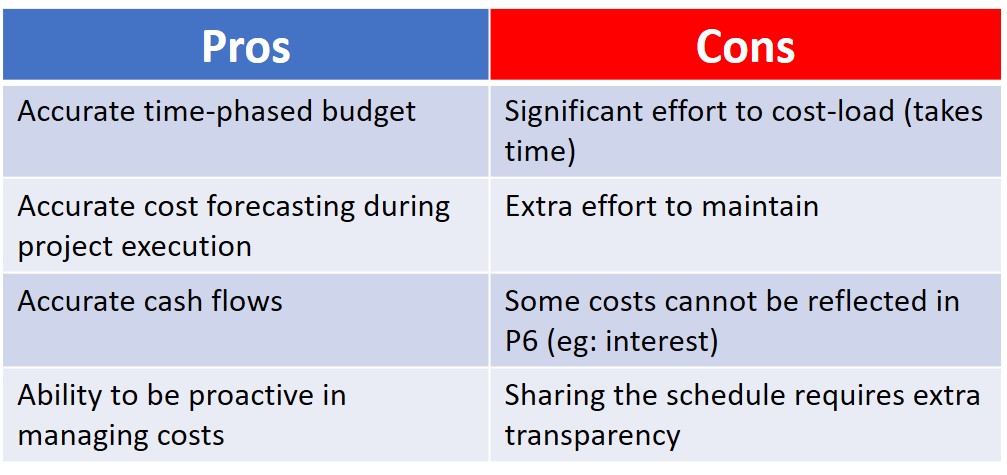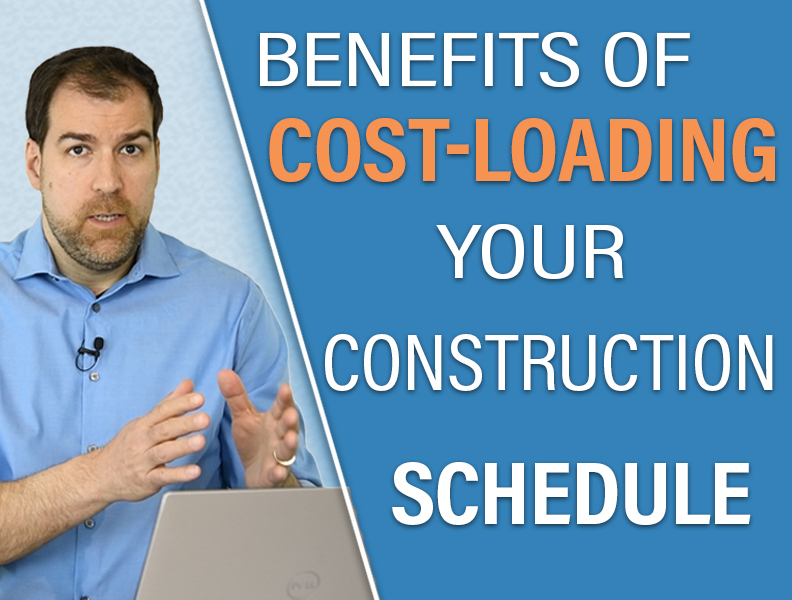Should you cost-load your construction project schedule? What are the benefits of cost-loading your schedule?
Whenever either construction Owners or Contractors are looking at a new project, that’s when these important questions come up.
I’m going to look at the benefits and tradeoffs of cost-loading a construction schedule from the perspectives of both the Owner and the Contractor.
Let’s dive in.
Let me start by saying that for many of us in the construction project management arena, scheduling and time management has been kept far away from project cost management.
What do I mean?
It’s been my experience that schedulers look at project dates, and someone else looks at costs. Probably someone with some formal cost management education, like a financial controller for example.
Pardon my boldness, but I believe that most schedulers know a lot about scheduling, and not much about the cost side of things like estimating, budgeting, and cost control (I know there are exceptions out there – I see you too!).
And it makes sense really. Cost management is, by its nature, more complex with many more rules to follow and plenty of risk.
Think of your own personal finances, your debts or your investment portfolio. If you manage these things in your personal life like I do, most of us recognize the intricacies that go into ensuring interest payments are minimized, understanding the fine print on our credit card statements, creating & calculating personal budgets and balancing security portfolios for the best return on our investments (ROI).
So when we start to consider the benefits & tradeoffs of cost-loading your schedule, many construction schedulers are at a disadvantage from the start because they have either been sheltered from the cost side of construction management or, the prospect of it makes them go “ugh”.
Yes, some of us gravitate towards cost spreadsheets, S-curves & cost accounts, while others do not. That’s a factor here as well.
Let’s explore why cost-loading your construction schedule can have solid benefits.
But let’s be real at the same time. I’ll also outline the tradeoffs for putting in the effort and help you decide whether it is worth it or not.
Watch the video below for a summary of this discussion:
Owner Benefits of Cost-Loading a Construction Schedule
Nowadays, depending on the size of your project, Owners are requesting more and more that Contractors submit a cost-loaded baseline schedule with cost-loaded updates.
I’ve seen quite a few Schedule Specifications outlining this request, primarily on medium to large jobs.
Why?
#1 Owners Want to Scrutinize How Their Money is Being Spent
It’s not surprising that Owners are interested in the on-going project financials and not just the dates. Owners themselves have stakeholders that need to be updated on the progress, risks and value of their investment.
Construction projects can take many twists and turns on the way to Total Completion, and Owners are more empowered to make key decisions during execution with a cost-loaded schedule in-hand.
#2 Owners Want to Forecast Cashflow
Owners, like Contractors, can use a time-phased cost-loaded schedule to predict demand for cash and expenditures. This information lets them be more proactive and informed on the cost-side.
#3 Claims Avoidance
Claims are costly on both sides and Owners definitely want to minimize construction delay claims. Of course the schedule will become a tool to resolve any claims.
The transparency required for a Contractor to provide a cost-loaded schedule can sometimes be a step toward a more collaborative relationship between Owner and Contractor (I know I take an idealist’s view here, but I gotta be me).
Contractor Benefits of Cost-Loading a Construction Schedule
Most Contractors are reluctant to cost-load their Construction project schedules. There’s a lot of work involved (to be discussed), and the rewards aren’t always clear to Contractors.
They’ve likely done many many smaller projects without a cost-loaded schedule, so the belief here is that project schedules should just scale to a large project with no changes in project controls procedures.
That’s not the case.
Here are the benefits to consider for Contractors:
#1 Track Earned Value
With cost-loading comes Earned Value Management. Contractors take advantage of Earned Value’s superior performance tracking over just comparing current dates to planned.
Earned Value Management lets Contractors see what they’ve earned based on their performance to better evaluate both schedule and cost overruns.
#2 Better Plan for Cost Outlays
A costed project schedule lets Contractors visualize cost spending based on timelines. It why we call it a time-phased budget.
Assigning costs to activities allows those costs to essentially move with activity dates. And thus, better planning from the cost and time perspective for the Contractor.
#3 Forecast Cashflow & Income from Owner
Remember a cost-loaded schedule will contain the planned costs outlined by the Contractor in the bid. These are the Contractors real costs plus a profit mark-up.
So Contractors can now forecast accurately income payments from the Owner based on their performance. This is actually a major benefit to help Contractors manage their cashflow and commitments.
Contractor Tradeoffs of Cost-loading a Schedule
It’s mostly pros for the Owner to have a cost-loaded schedule.
But the Contractor takes on the burden of work to produce the schedule. The table below summarizes the pros and cons of cost-loading a construction schedule.

#1 Effort vs Accuracy
Cost-loading a scheduling in P6 turns out is a lot of work. There’s a lot of work to ensure that each activity gets a cost.
AND we can’t skimp here by using WBS Summary activities or Level of Effort activities. It wipes out your ability to use Earned Value.
But don’t let that deter you right away. The benefits are significant.
a) There is no way to get an accurate forecast of costs unless you cost-load your schedule. Spreadsheets don’t cut it here because the date info is in P6.
b) Cost-curves and cost forecasts are easy to produce. Otherwise you’re making all sorts of guestimates with data in Excel. Here you get an accurate curve and forecast quickly.
I’ve seen contractors take the cost forecast report to their bank to negotiate for funding. There’s a lot of power in that.
Contractors have to weigh this decision.
#2 Accuracy vs Functionality
Tools like Microsoft Project, PowerProject and Primavera P6 are limited in their ability to handle sophisticated cost scenarios.
For example, recurring interest charges; Primavera P6 can’t calculate those.
Anything re-occuring must be manually setup. Interest charges must be manually calculated.
Yes, we can achieve *accurate* cost forecasting, but there are limits on what sorts of scenarios your scheduling tool can handle. Another decision for you to consider.
#3 Transparency
I think this one is most difficult for many Contractors. You will have to be very transparent on exactly what things cost, how you are spending, how you are progressing. You will have to answer questions, and be scrutinized.
This transparency will require some comfort adjustments.
But there’s a power in a Contractor being this vulnerable.
You’re showing that you’ve got nothing to hide. And that you can take on the work, be scrutinized and still succeed.
If you don’t put up a stink about cost-loading your schedule, more Owners will want to work with you, dear Contractor.
Conclusion
Is there a trend toward more Owners specifying cost-loaded schedules in their project contracts?
Definitely yes.
As projects get bigger, more complex, and especially with new agreements like Public-Private-Partnerships, the trend toward producing and managing cost-loaded construction schedules will likely continue to increase.
Want to learn more about how to Cost-Load schedules in Primavera P6?
Check out my Advanced P6 Schedule Building Course.


